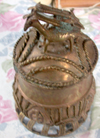Jan 25, 2016
Asante Gold Weights and Metalcasting
The Akan have a rich tradition in metal casting. Brass, copper, gold and iron have been the major metals with which Akan artisans shaped their tools for hunting and war, farming and domestic use, personal adornment, and for use as money. Archaeological evidence from the Begho in the Brong Ahafo Region indicates the presence of iron smelting in the area in the first millennium AD. The work of various archaelogists, notably Oliver Davies and Merrick Posnansky, has shown that smelting was once extensively carried on in parts of of the Akan area.
Changes which occurred through the growth of nucleated market centers, and through long distance trade with middle Niger towns such as Jenne resulted in technological innovations in copper and brass casting, and the exploitation and smelting of gold. Warren (1975) hypothesizes that Bron, as the first and northernmost Akan centralized state, must have passed on some of these technological developments to some of the latter-day Akan states (e.g., Asante) that came after Bron. Probably the most common Akan objects cast in brass were gold weights, spoons, kuduo and forowa (so-called "grease containers"), and jewelry. The casting of brass, silver, copper, and gold appears to have been regarded among the Akan as an ocupation entirely distinct from that of the blacksmith. Blacksmiths produced items such swords, knives, matchete, agricultural tools (e. g., axe and hoes) and traps, and door hinges and locks.
Click here to visit gallery

